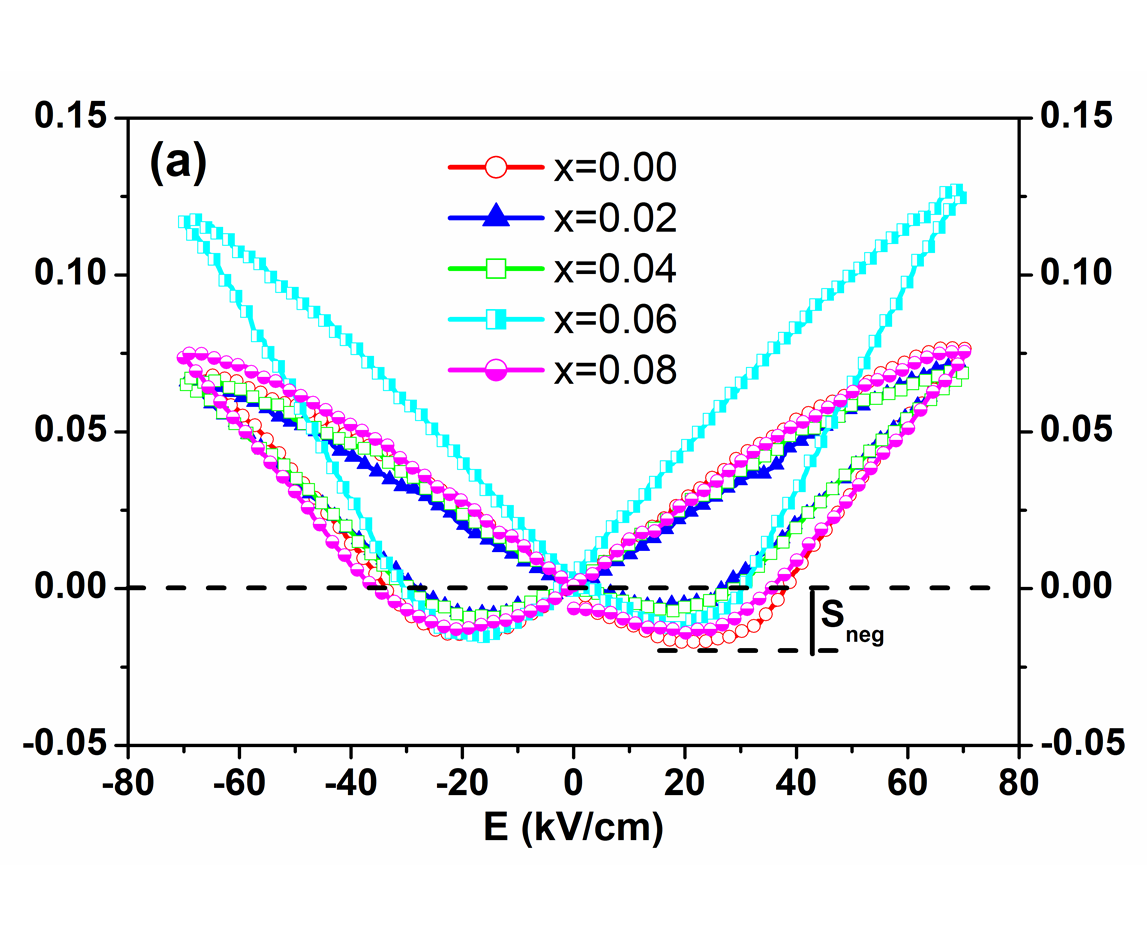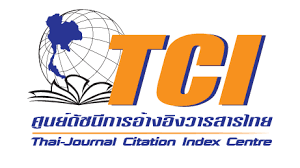Improvement in electrical and energy storage properties of lead-free BNKT-BT piezoceramics
DOI:
https://doi.org/10.55713/jmmm.v35i3.2339Keywords:
Lead-free piezoelectric, dielectric constant, energy storage, BNKT-BT ceramicAbstract
The electrical characteristics and energy storage performance of BNKT-BT lead-free piezoceramics were examined. All ceramics were produced via the mixed oxide technique. The findings indicated that the density of this ceramic system varied between 5.61 and 5.83 g/cm3. Conditions with 2.0 mol% (BT=0.02) and 6.0 mol% (BT=0.06) exhibited the largest dielectric constant (er) at both ambient temperature and elevated temperature, with values of 1307 and 4272, respectively. The ceramic sample with BT = 0.06 exhibited the highest values of %strain ~0.13 and a d*33 ~179.65 pm/V. Furthermore, BT-doped ceramics yielded optimal energy storage densities compared to undoped BNKT ceramics. The sample containing 4.0 mol% (BT=0.04) reached the maximum energy storage density (W ~0.31 J/cm3) with an energy storage efficiency (η ~ 37.89%).
Downloads
References
Z. L. Wang, and J. Song, “Piezoelectric nanogenerators based on zinc oxide nanowire arrays,” Science, vol. 312, pp. 242-246, 2006. DOI: https://doi.org/10.1126/science.1124005
G. A. Smolensky, “New ferroelectrics of complex composition IV,” Soviet physics. Solid state, vol 2, p. 2651, 1961.
H. Nagata, T. Shinya, Y. Hiruma, T. Takenaka, I. Sakaguchi, and H. Haneda, “Piezoelectric properties of bismuth sodium titanate ceramics,” Ceramic Transactions, vol 167, p. 213, 2005. DOI: https://doi.org/10.1002/9781118408186.ch20
T. Takenaka, K.O. Sakata, and K. O. Toda, “Piezoelectric properties of (Bi1/2Na1/2)TiO3-based ceramics,” Ferroelectrics,
vol. 106, no. 1, p. 375, 1990. DOI: https://doi.org/10.1007/BF00713395
W. Zhu, Z-Y. Shen, W. Deng, K. Li, W. Luo, F. Song, X. Zeng,
Z. Wang, and Y. Li, “A review: (Bi, Na)TiO3 (BNT)-based energy storage ceramics,” Journal of Materiomics, vol. 10, no. 1, pp. 86-123, 2024. DOI: https://doi.org/10.1016/j.jmat.2023.05.002
M. Benyoussef, M. Zannen, J. Belhadi, M. Bouchaib, J.L Dellis, and M.E. Marssi, “Dielectric, ferroelectric, and energy storage properties in dysprosium doped sodium bismuth titanate ceramics,” Ceramic International, vol. 44, no. 16, pp. 19451-19460, 2018. DOI: https://doi.org/10.1016/j.ceramint.2018.07.182
Q. Li, C. Zhou, J. Xu, L. Yang, X. Zhang, and W. Zeng, “Tailoring antiferroelectricity with high energy-storage properties in Bi0.5Na0.5TiO3-BaTiO3 ceramics by modulating Bi/Na ratio,” Journal of Materials Science Materials in Electronics, vol. 27, p. 10810, 2016. DOI: https://doi.org/10.1007/s10854-016-5187-9
T. Badapanda, S. Sahoo, and P. Nayak, “Dielectric, ferroelectric and piezoelectric study of BNT-BT solid solutions around the MPB region,” IOP Conference Series: Materials Science and Engineering, vol. 178, no. 1, 2017. DOI: https://doi.org/10.1088/1757-899X/178/1/012032
Z. Yang, B. Liu, and Y. Hou, “Structure and electrical properties of (1-x)Bi0.5Na0.5TiO3-xBi0.5K0.5TiO3 ceramics near morphotropic phase boundary,” Materials research bulletin, vol. 43, pp. 81-89, 2008. DOI: https://doi.org/10.1016/j.materresbull.2007.02.016
R. Sumang, T. Bongkarn, and N. Kumar, “Investigation of a new lead-free (1-x-y)BNT-xBKT-yBZT piezoelectric ceramics,” Ceramic International, vol. 43, pp. S102-S109, 2017. DOI: https://doi.org/10.1016/j.ceramint.2017.05.239
H. Yang, F. Yan, and Y. Lin, “Lead-free BaTiO3-Bi0.5Na0.5TiO3- Na0.73Bi0.09NbO3 relaxor ferroelectric ceramics for high energy storage,” Journal of the European Ceramic Society,” vol. 37, pp. 3303-3311, 2017. DOI: https://doi.org/10.1016/j.jeurceramsoc.2017.03.071
X. Ren, L. Jin, and Z. Peng, “Regulation of energy density and efficiency in transparent ceramics by grain refinement,” Chemical Engineering Journal, vol. 390, p.124566, 2020. DOI: https://doi.org/10.1016/j.cej.2020.124566
P. Jaita, K. Saenkam, and G. Rujijanagul, “Improvements in piezoelectric and energy harvesting properties with a slight change in depolarization temperature in modified BNKT ceramics by a simple technique,” RSC Advances, vol. 13, pp. 3743-3758, 2023. DOI: https://doi.org/10.1039/D2RA07587C
L.D. Vuong, and P.D. Gio, “Enhancement in dielectric, ferroelectric, and piezoelectric properties of BaTiO3-modified Bi0.5(Na0.4K0.1) TiO3 lead-free ceramic,” Journal of Alloys and Compounds, vol. 817, p. 152790, 2020. DOI: https://doi.org/10.1016/j.jallcom.2019.152790
H-l.Lian, X-j. Liang, M-n. Shi, L-n.Liu, and X-m.Chen. “Improved dielectric temperature stability and energy storage properties of BNT-BKT-based lead-free ceramics,” Ceramic International, vol. 50, no. 3, pp. 5021-5031, 2024. DOI: https://doi.org/10.1016/j.ceramint.2023.11.246
Z. Peng, J. Wang, M. Niu, X. Nie, S. Xu, F. Zhang, J. Wang, D. Wu, Z. Yang, and X. Chao, “Structure, electrical properties and energy storage performance of BNKT-BMN ceramics,” Journal of Materials Science Materials in Electronics, vol. 33, pp. 3053-3064, 2022. DOI: https://doi.org/10.1007/s10854-021-07507-9
Z. Yu, Y. Liu, and M. Shen, “Enhanced energy storage properties of BiAlO3 modified Bi0.5Na0.5TiO3-Bi0.5K0.5TiO3 lead-free antiferroelectric ceramics,” Ceramic International, vol. 43, pp. 653-7659, 2017. DOI: https://doi.org/10.1016/j.ceramint.2017.03.062
N. Chen, W. Yao, C. Liang, S. Xiao, J. Hao, Z. Xu, and R. Chu, “Phase structure, ferroelectric properties, and electric field-induced large strain in lead-free 0.99[(1-x)(Bi0.5Na0.5)TiO3-x(Bi0.5K0.5)TiO3]-0.01Ta piezoelectric ceramics,” Ceramic International, vol. 42, p. 9660, 2016. DOI: https://doi.org/10.1016/j.ceramint.2016.03.053
X. Wang, H. Gao, X. Hao, and X. Lou, “Enhanced piezoelectric, electrocaloric and energy storage properties at high temperature in lead-free Bi0.5(Na1-xKx0.5TiO3 ceramics,” Ceramic International, vol. 45, p. 4274, 2019. DOI: https://doi.org/10.1016/j.ceramint.2018.11.100
T. Takenaka, K. Maruyama, and K. Sakata, (Bi, Na)TiO3-BaTiO3 system for lead-free piezoelectric ceramics. Japanese Journal of Applied Physics, vol. 30, p. 2236, 1991. DOI: https://doi.org/10.1143/JJAP.30.2236
J. Y. Ha, J. W. Choi, C. Y. Kang, D. J. Choi, H. J. Kim, and S. J. Yoon, Materials Chemistry and Physics, vol. 90, p. 396, 2005.
J. Wu, D. Xiao, W. Wu, Q. Chen, J. Zhu, Z. Yang, and J. Wang, “Role of room-temperature phase transition in the electrical properties of (Ba, Ca)(Ti, Zr)O3 ceramics,” Scripta materialia, vol. 65, p. 771, 2011. DOI: https://doi.org/10.1016/j.scriptamat.2011.07.028
M. Promsawat, A. Watcharapasorn, and S. Jiansirisomboon, “Effects of ZnO nanoparticulate addition on the properties of PMNT ceramics,” Nanoscale Research Letters, vol. 7, p. 65, 2012. DOI: https://doi.org/10.1186/1556-276X-7-65
Y. Li, W. Chen, J. Zhou, Q. Xu, H. Sun, and R. Xu, “Dielectric and piezoelectric properties of lead-free (Na0.5Bi0.5)TiO3-NaNbO3 ceramics,” Materials Science and Engineering: B, vol. 112, p. 5, 2004. DOI: https://doi.org/10.1016/j.mseb.2004.04.019
K. Sakata, and Y. Masuda, “Ferroelectric and antiferroelectric properties of (Na0.5Bi0.5)TiO3-SrTiO3 solid solution ceramics,” Ferroelectrics, vol. 7, p. 347, 1974. DOI: https://doi.org/10.1080/00150197408238042
V. V. Shvartsman, and D. C. Lupascu, “Lead-free relaxor ferroelectrics,” Journal of the American Ceramic Society, vol. 95, p. 1, 2012. DOI: https://doi.org/10.1111/j.1551-2916.2011.04952.x
G. Hao, W. Bai, W. Li, B. Shen, and J. Zhai, “Phase transitions, relaxor behavior, and large strain response in LiNbO3-modified Bi0.5(Na0.80K0.20)0.5TiO3 lead-free piezoceramics,” Journal of Applied Physics, vol. 114, p. 044103, 2013. DOI: https://doi.org/10.1063/1.4816047
A. Chauhan, S. Patel, and R. Vaish, “Mechanical confinement for improved energy storage density in BNT-BT-KNN lead-free ceramic capacitors,” AIP Advances, vol. 4, p. 087106, 2014. DOI: https://doi.org/10.1063/1.4892608
R. A. Malik, A. Hussain, A. Maqbool, A. Zaman, T. K. Song, W. J. Kim, and M. H. Kim, “Giant strain, thermally-stable high energy storage properties and structural evolution of Bi-based lead-free piezoceramics,” Journal of Alloys and Compounds, vol. 682, p. 302, 2016. DOI: https://doi.org/10.1016/j.jallcom.2016.04.297
A. Zaman, Y. Iqbal, A. Hussain, M. H. Kim, and R. A. Malik, “Dielectric, ferroelectric, and field-induced strain properties of Ta-doped 0.99Bi0.5(Na0.82K0.18)0.5TiO3–0.01LiSbO3 ceramics,” Journal of Materials Science, vol. 49, p. 3205, 2014. DOI: https://doi.org/10.1007/s10853-014-8024-7
X. Zhou, G. Xue, H. Luo, C.R. Bowen, and D. Zhang, “Phase structure and properties of sodium bismuth titanate lead-free piezoelectric ceramics,” Progress in Materials Science, vol 122, p. 100836, 2021. DOI: https://doi.org/10.1016/j.pmatsci.2021.100836
J. Moulson, and J.M. Herbert, “Electroceramics materials, properties, applications,” 2nd ed., New York: Wiley, 2003. DOI: https://doi.org/10.1002/0470867965

Downloads
Published
How to Cite
License
Copyright (c) 2025 Journal of Metals, Materials and Minerals

This work is licensed under a Creative Commons Attribution-NonCommercial-NoDerivatives 4.0 International License.
Authors who publish in this journal agree to the following terms:
- Authors retain copyright and grant the journal right of first publication with the work simultaneously licensed under a Creative Commons Attribution License that allows others to share the work with an acknowledgment of the work's authorship and initial publication in this journal.
- Authors are able to enter into separate, additional contractual arrangements for the non-exclusive distribution of the journal's published version of the work (e.g., post it to an institutional repository or publish it in a book), with an acknowledgment of its initial publication in this journal.












